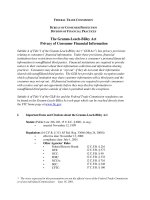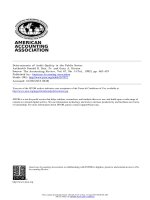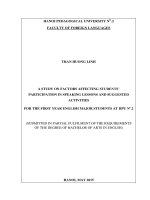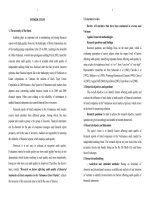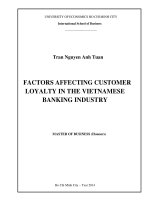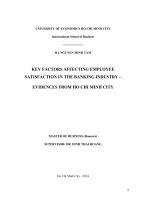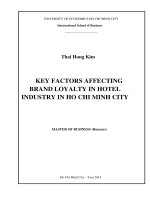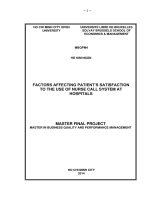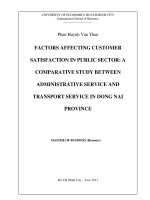Factors Affecting Audit Quality in the 2007 UK Regulatory Environment: Perceptions of Chief Financial Officers, Audit Committee Chairs and Audit Engagement Partners ppt
Bạn đang xem bản rút gọn của tài liệu. Xem và tải ngay bản đầy đủ của tài liệu tại đây (225.78 KB, 42 trang )
1
Factors Affecting Audit Quality in the 2007 UK Regulatory
Environment:
Perceptions of Chief Financial Officers, Audit Committee Chairs and
Audit Engagement Partners
Vivien Beattie,
a
Stella Fearnley
b
and Tony Hines
c
Draft date: April 2010
a
Vivien Beattie (corresponding author)
Professor of Accounting
Dept. of Accounting and Finance, University of Glasgow
West Quadrangle, Main Building
University Avenue
Glasgow G12 8QQ
Tel. +44(0)141 330 6855
Email
b Stella Fearnley
Professor of Accounting
Department of Accounting and Finance, Bournemouth University
Dorset House, Talbot Campus
Fern Barrow
Poole
Dorset BH12 5BB
Tel. +44(0)1202 965829
c.
Tony Hines
Principal Lecturer in Accounting
Portsmouth Business School, University of Portsmouth
Richmond Building
Portland Street
Portsmouth PO1 3DE
Tel. +44(0)23 92844156
Acknowledgments:
We would like to thank The Institute of Chartered Accountants in England and Wales’
charitable trusts for financial support on this project. Thanks also go to: John
Coombe, Ken Lever, Ian Percy and Gerald Russell who have acted as general advisors
to the project (including pilot testing the questionnaire); Steve Maslin who also helped
pilot test the questionnaire; and the 100 Group of Finance Directors, the ICAEW’s
Audit and Assurance Faculty and eleven audit firms who gave their support. We
gratefully acknowledge the helpful comments received on previous drafts of this
paper from Sir John Bourn, participants at the National Auditing Conference, Exeter,
March 2009 and participants at the Fifth EARNet Symposium, Valencia, October
2009. Particular thanks go to the 498 individuals who completed the questionnaire on
which this paper is based.
2
Factors Affecting Audit Quality in the 2007 UK Regulatory
Environment:
Perceptions of Chief Financial Officers, Audit Committee Chairs and
Audit Engagement Partners
ABSTRACT
In line with global changes, the UK regulatory regime for audit and corporate
governance has changed significantly since the Enron scandal, with an increased role
for audit committees and independent inspection of audit firms. UK listed company
chief financial officers (CFOs), audit committee chairs (ACCs) and audit partners
(APs) were surveyed in 2007 to obtain views on the impact of 36 economic and
regulatory factors on audit quality. 498 usable responses were received, representing
a response rate of 36%. All groups rated various audit committee interactions with
auditors among the factors most enhancing audit quality. Exploratory factor analysis
reduces the 36 factors to nine uncorrelated dimensions. In order of extraction, these
are: economic risk; audit committee activities; risk of regulatory action; audit firm
ethics; economic independence of auditor; audit partner rotation; risk of client loss; audit
firm size; and, lastly, International Standards on Auditing (ISAs) and audit inspection.
In addition to the activities of the audit committee, risk factors for the auditor (both
economic and certain regulatory risks) are believed to most enhance audit quality.
However, ISAs and the audit inspection regime, aspects of the ‘standards-surveillance-
compliance’ regulatory system, are viewed as less effective. Respondents commented
that aspects of the changed regime are largely process and compliance driven, with
high costs for limited benefits, supporting psychological bias regulation theory that
claims there is overconfidence that a useful regulatory intervention exists.
Keywords: audit quality, regulation, audit committees; audit inspection; ISAs.
1
Factors Affecting Audit Quality in the 2007 UK Regulatory
Environment:Perceptions of Chief Financial Officers, Audit Committee Chairs
and Audit Engagement Partners
INTRODUCTION AND MOTIVATION FOR THE STUDY
The economic crisis is the latest event to raise interest globally in audit quality, the
integrity of financial reporting and corporate governance. The scale of the problem
has also raised expectations of further regulation in the banking sector which may
well impact on reporting, auditing and governance outside this sector. National
regulatory systems are increasingly interconnected with supranational private sector
standard setting bodies, such as the International Accounting Standards Board
(IASB), the International Federation of Accountants (IFAC) and governmental bodies
such as the European Union (EU) (e.g., Cooper and Robson, 2006: 430).
However, interest in audit quality and in related changes in regulation and practice
have been ongoing for many years. Reviewing trends in US audit regulation, Kinney
(2005) observes that the 1980s heralded in a period of de-regulation (consistent with
policy shifts to allow competition and market forces greater influence). Some writers
argue that this period of regulatory capitalism was instrumental in the emergence of
conceptions of the audit as a commodity driven by economic considerations of the
auditee management and the need to deliver added value to the client company
(Jeppesen, 1998; Windsor and Warming-Rasmussen, 2009). In the practice field,
business risk auditing approaches emerged in the 1990s (Power, 2007).
The Enron scandal in 2002, however, prompted a global shift to re-regulation
(Kinney, 2005). In the US, the Sarbanes Oxley Act (SOX) (2002) introduced major
changes to the US audit, financial reporting and corporate governance regimes.
Similar regulatory changes subsequently occurred in the UK and many other countries
(Lennox, 2009). Scandal and regulatory change has brought attendant changes in the
conceptualisation of practice. For example, Khalifa, Sharma, Humphrey and Robson
(2007) present evidence that the dominant audit discourse shifted from one of
‘business value’ to one of ‘audit quality’.
2
The loss of Enron’s audit firm, Andersens, left only four major firms dominating the
global audit market and led to an overall loss of confidence in audit quality which
affected the remaining firms and created concerns about competition and choice for
major companies using audit services in this market (e.g. General Accounting Office
(GAO), 2003; US Treasury, 2007; FRC, 2007; EC, 2008). Generally, however, it was
concluded that market-led solutions were to be encouraged in the first instance (GAO,
2008; FRC, 2008). SOX made significant changes to the US listed company auditing
and governance regimes including: inspection of listed company audits by a new
independent agency, the Public Company Accounting Oversight Board (PCAOB);
independent setting of auditing standards; restriction of non-audit services; and a
requirement for greater engagement with the auditors by the company audit
committee.
Confidence in audit quality was not just a problem in the US. As Andersen was a
global firm, audit clients and regulators in many other countries were affected.
Ensuring that the remaining firms carried out high quality audits in the future was
seen as paramount to making sure that no other firms failed. Thus many changes to
the regulatory regime for auditors were also made in other jurisdictions including the
UK and the EU. Following a government review (CGAA, 2003), major changes in
the UK included the restructuring of the Financial Reporting Council (FRC) which
took responsibility for setting auditing standards, setting ethical standards for auditors
and conducting independent inspections of public interest audits. The review also
included changes to the UK Combined Code for Corporate Governance requiring
much closer engagement between the audit committee of a company and its auditors,
thus creating a much more significant role for the audit committee chair (ACC) in the
audit process (FRC, 2003). A further major change in the EU was the move to
International Financial Reporting Standards (IFRS) in 2005 for the group accounts of
all companies listed on EU markets. This change required the input of significant
resources for all companies (Dunne, Fifield, Finningham, Fox, Hannah, Helliar,
Power and Veneziani, 2008).
Given the enhanced role of the audit committee in the relationship between a
company and its auditors, the audit committee chair (ACC) is now a key party in the
audit process. There have been no studies in the UK or other jurisdictions which have
3
simultaneously sought the views of the three key preparer groups (i.e. chief financial
officers (CFOs), ACCs and audit engagement partners (APs) on the impact of the post
Enron regime on audit quality. The most recent UK study was carried out before the
post-Enron changes were introduced (Duff, 2004).
Sadly, this avalanche of regulation has not prevented the meltdown in the banking
sector that western economies have recently experienced. Some observers have
questioned whether audit quality failures contributed to the crisis (e.g., Holmes and
Sukhraj, 2008; Sikka, 2009). However, the UK Parliament Treasury Committee, as
part of its Inquiry into the Banking Crisis, investigated the role of auditors (Treasury
Committee, 2009) and concluded that they
‘had received very little evidence that auditors failed to fulfil their duties as
currently stipulated. The fact that some banks failed soon after receiving
unqualified audits does not necessarily mean that these audits were deficient.
But the fact that the audit process failed to highlight developing problems in
the banking sector does cause us to question exactly how useful audit
currently is. We are perturbed that the process results in “tunnel vision”,
where the big picture that shareholders want to see is lost in a sea of detail
and regulatory disclosures’ (Paragraph 221).
The aim of the present study is to evaluate, from the preparer and auditor
perspectives, the effectiveness of recent changes to the audit regulatory landscape.
Specifically, the study: (a) identifies the extent to which CFOs, ACCs and APs of UK
listed companies believe that key features of the 2007 regulatory environment (which
has since changed little) enhance or undermine audit quality; (b) establishes whether
the responses differ significantly depending on respondents beliefs regarding the
value of audit to the company or client; and (c) identifies the changes to either the
regulatory framework or the behaviour of auditors which the respondents believe
would most improve audit quality. The research is carried out by means of a
contemporaneous survey of all three groups. New regulatory factors are considered
alongside pre-existing regulatory and economic factors in order that the relative
effectiveness of new regulation can be assessed in context.
Given that this study was carried out in 2007 and concerns about the role of audit
were expressed by the Treasury Committee based on the bank audits with 2007 year
ends, the research findings are also considered in the context of the conclusions drawn
by the Treasury Committee (2009) in relation to the regulatory framework.
4
The findings of this research should provide policy makers with valuable evidence to
inform future policy in relation to the desirability of and attitudes to further changes to
the UK and other regimes that may be considered in response to the economic crisis.
In recent years, there has been a growing call for evidence-based policy making that
assesses the effects of financial regulation, including the costs, benefits and
particularly the unintended consequences (Buijink, 2006; Pawson, 2006; Mulherin,
2007; Schipper, 2009).
The paper is constructed as follows: Section two provides more detail about the 2007
UK regulatory framework and also includes an overview of the literature on
regulation and audit quality. Section three describes the research methodology and
research questions. Section four provides the results and section five summarises and
concludes.
REGULATORY CHANGE IN THE UK AND LITERATURE REVIEW
Changes to the UK regulatory regime
UK-specific changes include the UK’s own response to the Enron crisis (CGAA,
2003) and the 2006 Companies Act. The CGAA review resulted in the Accountancy
Foundation (the oversight body established by the accountancy professional bodies in
2002) being replaced by a restructured FRC, with several new operating bodies.
Originally set up in 1992, the FRC’s remit was to set and enforce accounting
standards (via the Accounting Standards Board (ASB) and the Financial Reporting
Review Panel (FRRP)) and to maintain the Combined Code for Corporate
Governance. Its responsibilities were extended to include control of the Auditing
Practices Board (APB), the Accountancy and Actuarial Discipline Board (AADB) and
general oversight via the Professional Oversight Board (POB)).
1
The effect of this
was to remove completely any responsibility for audit standard setting and oversight
of the profession from the accountancy professional bodies.
The Financial Reporting Review Panel (FRRP), which is responsible for ensuring
compliance with accounting requirements, added risk based pro-active monitoring of
the financial statements of public interest entities to its existing model of reacting to
5
complaints and publicly available information. The FRRP now selects industry
sectors and specific areas of financial information, combined with an assessment of
company specific risk factors. Its remit was also extended to monitoring the
requirements of the UK listing rules (FRC, 2005: 7).
In addition to its existing duties of setting auditing standards, the APB took
responsibility for setting ethical standards for auditors. Two key provisions of the
ethical standards, which reflect the European Commission’s (EC) fundamental
principles for auditor independence (European Commission, 2002), are: mandatory
rotation of all partners on each listed company audit, with the audit engagement
partner in the UK rotating every five years; and greater restrictions on the provision of
non-audit services (APB, 2004a). The POB became responsible for the inspection of
public interest audits and the publication of the results of the inspections. This work
is carried out by the POB’s Audit Inspection Unit (AIU, 2008).
Further regulatory developments have occurred that affect the auditing environment
since these regulatory structures were put in place. International Standards on
Auditing (ISAs) were adopted by the APB (adapted for the UK environment) (APB,
2004b) and became mandatory for all UK audits from December 2005 year ends
onwards. In early 2009, the International Auditing and Assurance Standards Board
(IAASB) completed its 5 year long project to ‘clarify’ ISAs.
2
The EU issued the
revised 8th Statutory Audit Directive and ethical standards for auditors were amended
to ensure that they would be consistent with changes in the law which were to arise
from the implementation of this Directive in 2008 (APB, 2007).
In the area of accounting regulation, EU legislation mandated the use of IFRS by UK
listed companies in their consolidated financial statements for December 2005 year
ends, replacing UK GAAP (EU, 2002). This caused significant changes in accounting
and hence auditing practice. In particular, IFRS do not clearly state the ‘substance
over form’ principle of FRS 5 Reporting the Substance of Transactions (ASB, 1994).
Decisions to extend the use of IFRS to other company accounts, was left to member
states to decide. In the UK entities were permitted to choose either UK GAAP or
IFRS.
6
The third audit-related regulatory sphere to experience significant change was
corporate governance. A formal framework emerged from the UK financial scandals
of the early 1990s in the form of the Cadbury Report (1992) which subsequently
became the Combined Code (and is soon to become the UK Corporate Governance
Code). The UK market regulator, the Financial Services Authority, requires listed
companies to provide a ‘comply or explain’ statement in their annual report which
sets out how the Combined Code has been applied by the company (FRC, 2006a).
3
Code provision C3.1 states that ‘The board should establish an audit committee of at
least three or in the case of smaller companies two, members, who shall all be
independent non-executive directors. The board should satisfy itself that at least one
member of the audit committee has recent and relevant financial experience.’ The
responsibilities of the audit committee include monitoring ‘the integrity of the
financial statements of the company…reviewing significant financial reporting
judgments contained in them’ (provision C3.2). The auditor’s responsibilities in
relation to communication with those charged with governance are contained in ISA
(UK and Ireland) 260 (APB, 2004c). Timely communication with the relevant parties
in the company is required about audit matters.
To summarise, UK re-regulation in the audit arena post-Enron has been significant.
There are now more regulatory bodies (e.g. the FRC’s AIU) and these bodies they
have a more intrusive mandate (e.g. FRRP now takes a proactive rather than a reactive
approach) (Kershaw, 2006: 389).
Regulation theory
The literature on regulation adopts different theoretical perspectives, with the
principal espoused approach drawing on the economics discipline (regulatory
economics and public policy economics). Evidence of market failure, often combined
with regulatory impact analysis, is used to justify the need for regulation on social
welfare grounds. Regulatory impact analysis, however, does not necessarily identify
the unintended consequences (often undesirable) of regulatory intervention.
If the case for market intervention is made, the general form of regulation must be
decided. The main alternative regulatory forms (self-regulation versus government
regulation) represent the classic trade-off between independence and expertise
4
. The
7
regulatory economics literature argues that the potential efficiency gains from self-
regulation are attributable to the producers’ superior knowledge of the issues, their
greater ability to adapt to changing institutional conditions and the lower transaction
costs of the regulatory process. To be set against this is the risk of self-interested
participation in the process (Grajzl and Murrell, 2007). In the government model,
however, regulatory capture is also a danger (Dal Bo, 2006). Beyond the general form
of regulation, specific choices must be made in relation to, for example, self-reporting
versus traditional direct monitoring of violations and inspection regimes. However,
despite the risk of capture, the aftermath of the Enron collapse and loss of confidence
in the accountancy profession led to a further move away from professional self
regulation to regulation by a government agency, the FRC.
In the financial arena, regulation encompasses the regulation of both rules (standards
and guidelines) and the groups subject to the rules (e.g. share dealers, accountants and
auditors). Hirschleifer (2008), a behavioural financial economist, proposes a
psychological, rather than an economic, theory of financial regulation. He argues that
‘certain beliefs about regulation are especially good at exploiting psychological biases
to attract attention and support. This irrationality, especially of the proponents of
regulation, pervades the political discourse of regulation and strengthens the case for
laissez-faire. Several underlying social and psychological processes in financial
regulation are identified. Salience and vividness effects (i.e. events that draw
attention), the violation of fairness and reciprocity norms, scapegoating, the
availability heuristic amplified by media attention are all illustrated by the Enron
scandal and the subsequent enactment of SOX. There also exists inherent
overconfidence that a useful regulatory solution exists. Hirschleifer recommends that
regulatory inertia should be built into the system to counteract the detrimental effect
of these biases at the societal level.
Accounting and auditing regulation involves, prima facie, the professional
accountancy associations, standard-setting bodies and regulatory agencies.
Additionally, however, the professional firms (especially the global Big Four) are an
increasingly important ‘node in the network of institutions through which regulatory
and professional processes operate’ (e.g., Cooper and Robson, 2006, p.417). Adopting
a political science perspective, Cooper and Robson (2006) argue that regulation has
8
been used to restore trust, a view which resonates with Hischleifer’s (2008) scapegoat
bias. Humphrey, Loft and Woods (2009) explore the impact of the financial crisis on
the international financial architecture of the last decade, which can be characterised
as a ‘standards-surveillance-compliance’ system based on transparency (Wade, 2007).
They conclude that, in the wake of the crisis, this system is being strengthened, rather
than changed. This system of financial regulation, which emphasises calculable
standards and outcomes, arguably mirrors the rise of new managerialism in the fields
of education and the public sector.
Research into audit quality
Audit quality can be conceptualised as ‘a theoretical continuum ranging from very
low to very high’ (Francis, 2004: 346.). DeAngelo’s (1981: 186) seminal economic
analysis defines audit quality as the ‘market-assessed joint probability that a given
auditor will both (a) discover a breach in the client’s accounting system and (b) report
the breach’. Subsequently, however, researchers have recognised that these two
characteristics of competence and independence do not represent the whole spectrum
of audit quality attributes, with the effectiveness of the regulatory framework, service
quality and responsiveness also being important aspects (e.g. Warming-Rasmussen
and Jensen, 1998; Duff, 2004).
Recently, the FRC (2006b) considered how to identify the drivers of audit quality and
promote audit quality. Having identified the lack of a clear agreed definition of audit
quality, the FRC cites a key definition provided by the AIU (FRC, 2006b: 19):
‘Undertaking a quality audit involves obtaining sufficient and appropriate
audit evidence to support the conclusions on which the audit report is based
and making objective and appropriate audit judgments. A quality audit [also]
involves appropriate and complete reporting by the auditors which enables the
Audit Committee and the Board properly to discharge their responsibilities.’
The FRC subsequently issued its Audit Quality Framework (FRC, 2008) which
identified five drivers of audit quality: the culture within an audit firm; the skills and
personal qualities of audit partners and staff; the effectiveness of the audit process; the
reliability and usefulness of audit reporting; and factors outside the control of auditors
affecting audit quality.
9
As the audit process is unobservable, the appearance as well as the fact of the
behaviour of auditors is essential to public confidence in the value of audit.
DeAngelo (1981) refers to this as the ‘market-assessed’ probability of breach
detection and reporting. Quantitative archival empirical research into audit quality
has used various observable outcomes to proxy for audit quality, such as: audit
opinions; auditor selection and change decisions; financial statement outcomes; and
analysts’ forecasts. Reviewing 25 years of empirical audit quality research, Francis
(2004) concludes that the most significant development in audit quality research is
grounded in the assumption that differences in audit quality exist and can be inferred
by comparing different groups of auditors. The main basis of differentiation is
between large and small auditors (typically the Big Four versus the non-Big Four). It
is argued that large audit firms are less dependent on any single client and also that
they have incentives to protect their brand name. Research has shown that there is
demand for quality-differentiated audits and that the top tier audit firms are higher
quality (have lower thresholds for issuing modified audit reports and more effectively
curtail aggressive earnings management).
Other archival approaches to researching audit quality have examined, inter alia: audit
firm and audit partner rotation; the impact of corporate governance characteristics; and
the impact of audit firm review and inspection. Each of these is briefly considered.
Long audit firm tenure is believed by some to lead to overly ‘cosy’ relationships between
the auditor and the client company management and a loss of independence. Mandatory
audit firm rotation has been called for called for to remedy this situation. Others argue
that auditors’ independence incentives are sufficient and that the inevitable learning
curve of incoming auditors could lead to lower quality audits in the early years. A less
radical intervention is to require audit partner rotation. A five year rotation period was
introduced in many jurisdictions post-Enron (e.g. SEC, 2003). The evidence is mixed -
studies set in Australia have shown that audit quality improves upon audit partner
rotation (e.g. Fargher, Lee and Mande, 2008), whereas recent German evidence shows
no association between mandatory audit engagement partner rotation and audit quality,
but does find that audit quality declines upon the rotation of the audit review partner
(Watrin, Lindscheid and Pott, 2009). In the UK, the APB recently proposed that the
rotation period specified in the Ethical Standards for Auditors be increased from five to
10
seven years (APB, 2009a), although the arguments for both periods were described as
‘finely balanced’. The revised ethical standard allows this extended period for the audit
engagement partner of listed companies only if the audit committee determine that it is
necessary to safeguard audit quality, with disclosure to the shareholders (APB, 2009b,
§16-17). The period for engagement quality control reviewers and key partners is seven
years (§19).
Agrawal and Chadha (2005) analyse a US dataset of audit committee and other corporate
governance characteristics in relation to earnings misstatements. They find that the
independence of the audit committees did not influence the frequency of restatements,
although the presence of an independent director with financial expertise did reduce the
frequency of restatements.
In many countries, systems of audit firm review and inspection have changed
significantly in recent years. From 1988 until 2002, audit firms operating in the US with
SEC clients were subject to mandatory peer review every three years, with the results of
this review being publicly disclosed.
5
Hilary and Lennox (2005) find that audit firms
gained clients following receipt of a clean opinion and lost clients following receipt of an
adverse opinion, suggesting that the process credibly signaled audit quality, a conclusion
confirmed by Casterella, Jensen and Knechel (2009). Following SOX, this model was
replaced by independent inspections carried out by the PCAOB. Lennox and Pittman
(2010) find that audit firms’ market shares are not sensitive to these reports. They
conclude that this may be because the inspectors are not seen to possess adequate
technical knowledge and/or because the PCAOB reports are less informative that the
peer review reports (as they do not disclose quality control problems). DeFond (2010)
points out that this conclusion must be tempered by consideration of several related
issues: (i) a lack of information value does not necessarily mean that the inspections are
ineffective; (ii) the new regime may be effective in providing ex ante incentives for audit
quality to improve, by applying stricter standards and/or imposing more severe penalties;
(iii) the quality of financial reporting may have improved post SOX. By contrast, in the
Dutch setting, Van de Poel, Opijnen, Maijoor and Vanstraelen (2009) conclude that
independent inspections are effective in detecting audit quality.
11
The advantage of these indirect, archival approaches is that real-world data are used;
however, the causal connection between the variables of interest is not always clear-cut.
Research designs that employ direct methods, rather than indirect methods, include
experimental and survey studies. In an experiment using Danish auditors, Windsor and
Warming-Rasmussen (2009) find that the majority of auditors were not consistently
independent in the context of client economic factors (client financial condition, size
of fees and whether audit is tendered), indicating that IFAC’s code of ethics appeal to
‘independence of mind’ is not effective.
There have been relatively few surveys of attitudes and beliefs regarding audit quality
and what the key dimensions are. An advantage of this research approach is that the
relative importance of a range of factors can be assessed. Carcello, Hermanson and
McGrath (1992) survey preparers, auditors and users in the US and find that important
factors are: knowledge of the client; industry expertise; responsiveness; and compliance
with auditing standards. Post-SOX, 82% of 253 US audit committee members surveyed
believe that audit quality has improved (Center for Audit Quality, 2008). The reasons
for improvement were identified as being: increased audit committee oversight;
requirements regarding internal controls; better communication with audit committees;
CEO/CFO sign-off on financial statements; increased emphasis on quality of auditors;
more rigorous audits; and audit committee oversight of auditors. Interview evidence
from US company directors indicates that new regulation on the management-external
auditor-audit committee relationship has improved audit quality, although there are
suggestions that this benefit has involved costly compliance (Cohen, Hayes,
Krishnamoorthy, Monroe and Wright, 2009). In Australia, interviews with key
stakeholders reveal that the introduction of legally enforceable Australian Auditing
Standards has not increased perceived audit quality (Hecimovic, Martinov-Bennie and
Roebuck, 2009).
In the UK, Beattie, Fearnley and Brandt (1998, 1999) find that the factors that audit
partners, finance directors and financial journalists most believed to enhance auditor
independence in the pre Enron environment were: existence of an audit committee; risk
of referral to the FRRP ; and risk to the audit firm of loss of Registered Auditor Status.
Duff (2004) distinguishes between technical quality and service quality in a survey
carried out in 2001-2 before the post Enron changes were implemented. It is found that
12
technical quality is characterised by status, independence and knowledge, while service
quality is characterised by responsiveness, non-audit services and understanding of the
client. In a UK investor survey about independence threats, Dart (2009) finds
economic dependence in general and non-audit service provision in particular to be
the most serious threats. The post Enron changes in the UK have significantly limited
the opportunities for non-audit services provision, although economic dependence is
still considered to be a threat.
To date, however, there have been no studies undertaken in the changed UK
environment which have sought the views on audit quality of CFOs, audit partners, and,
importantly, audit committee chairs. The present study seeks to fill this lacuna.
RESEARCH QUESTIONS AND METHODOLOGY
Research questions
Many regulatory changes impacting on the audit process have been implemented in
the past few years. The focus of this study is to elicit the views of three key participant
groups in the audit / financial reporting process, CFOs, ACCs and APs, on the features
of the economic and regulatory environment which influenced audit quality in 2007, just
before the current financial crisis emerged. We are particularly interested in the
perceived effectiveness of the new (post-SOX) regulatory factors compared to pre-
existing regulatory factors and continuing economic factors such as economic
dependence. Our first detailed research question, which serves to contextualise the
responses given, is:
Research question 1:To what extent do CFOs, ACCs and APs of UK listed companies
companies believe the audit service is valuable to their
company / client?
Research question 2: To what extent do CFOs, ACCs and APs of UK listed
companies believe key factors in the 2007 UK regulatory
framework and audit environment enhance or undermine audit
quality?
13
Within the results of the combined sample there may be some contrasting respondent
perceptions. Hence:
Research question 3: Do responses differ significantly by:
a) respondent group;
b) the extent to which respondents value audit?
To obtain a fuller understanding of where the 2007 framework might be considered
deficient, we seek the views of respondents regarding possible improvements. Hence:
Research question 4: What changes to the regulatory framework, or to the behaviour
of auditors, do respondents believe would most improve audit
quality?
In 2009, the UK Treasury Committee, in its Inquiry into the Banking Crisis,
questioned the usefulness of audit and suggested that the ‘big picture was lost in a sea
of detail and regulatory disclosures’ (Treasury Committee, 2009, paragraph 221).
Hence:
Research question 5: To what extent do the findings of this study support the views of
the Treasury Committee about audit being ‘lost in a sea of
detail and regulatory disclosures’ and indicate a possible
unintended consequence of the changed regulatory regime?
Methods
The sample was taken from officially listed UK domestic companies, excluding AIM
companies and investment trusts.
6
A target sample size of 500 for each group was
initially set, including the top 250 qualifying companies by market capitalisation (as at
5
th
February 2007) and a systematic sample (every nth company ranked by market
capitalisation) of 250 from the remaining qualifying companies.
7
To eliminate multiple
selections of audit committee chairs, the final sample of ACCs was reduced to 446.
8
AP respondents (i.e. those acting as engagement partner for qualifying companies) were
identified by the 11 largest UK firms. This information was not publicly available. 439
14
audit partners were identified for survey, which is close to the UK population of listed
company audit partners. For company specific questions audit partners were asked to
respond in respect of their largest listed company client, referred to as ‘Client X.’.
The research instrument used a combination of closed-form and open questions. CFOs
and ACCs were asked to value audit on a five point scale (from not at all to very
valuable); APs were asked how their client valued audit. This data is used as a basis
for further analysis.
The main part of the survey sought respondents’ views on factors affecting audit quality.
The definition of audit quality in the survey instrument was taken from the UK Financial
Reporting Council’s definition in their 2006 consultation:
‘Obtaining sufficient and appropriate audit evidence to support the conclusions
on which the audit report is based and making objective and appropriate audit
judgements. It involves appropriate and complete reporting by the auditors
which enables the Audit Committee and the Board properly to discharge its
responsibilities.’ (FRC, 2006b: 19)
A total of 36 factors were listed, grouped into:
a. Economic and general regulatory factors;
b. Standards set by the Auditing Practices Board;
c. Activities of the audit committee.
The factors are listed in Table 1.
[Table 1 about here]
Respondents were asked to evaluate the impact of each factor on audit quality on a scale
of 1 to 7, where 1 = serious undermines; 2 = moderately undermines; 3 = slightly
undermines; 4 = no effect; 5 = slightly enhances; 6 = moderately enhances; 7 =
greatly enhances. Finally, an open question invited respondents to give their opinion
on the changes to the regulatory framework, or to the behaviour of auditors which
would most improve audit quality.
A draft questionnaire was pretested with several finance directors, audit committee
chairs and audit partners involved with listed companies. Questionnaires to CFOs and
ACCs were sent direct by the researchers in June 2007. The AP surveys were distributed
15
at the same time by the firms. All responses were returned direct to the researchers.
Two reminder letters were sent and the audit firms followed up at the same time.
Response rates and tests for bias
For the CFO sample of 500, 149 usable responses were received, representing a response
rate of 30%; for the ACC sample of 446, 130 usable responses were received,
representing a response rate of 29%; and for the AP sample of 439, 219 usable responses
were received, representing a response rate of 50%. These rates compare very
favourably with the rates typically obtained in recent years from senior executives (for
example, Daugherty and Tervo (2008) obtain a response rate of 5.5% from a survey of
CFOs, ACCs and CEOs of the S&P 500).
To test for response bias, responders and non-responders in the CFO and ACC groups
were compared on the basis of several background characteristics. Table 2 provides an
analysis of the respondents by Stock Exchange group, US listing, audit firm type and
broad industry sector. It is apparent that the characteristics of the respondent groups are
broadly comparable. There is no significant difference in the proportion of US listings
across the 3 groups (
χ
2
= 2.800; p = 0.247), or the proportion of non-Big 4 affiliated
respondents (χ
2
= 2.157; p = 0.340), or the proportion of respondents affiliated to
financial sector companies versus non-financial sector companies (χ
2
= 3.830; p =
0.147)
9
. There are, however, differences in the distribution across Stock Exchange
groups (χ
2
= 16.823; p = 0.010). In particular, there are a higher proportion of Fledgling
respondents among the CFO sample, and more FTSE 250 respondents among the ACC
sample.
[Table 2 about here]
The validity of questionnaires can also be affected by the suitability of individual
respondents, who should be both knowledgeable and involved in the relevant practices,
usually at a senior level. CFO respondents, based on job title, were CFO/Group CFO
(74%), financial controller (9%), (group) chief accountant (3%), deputy CFO (1%) and
other/non stated (13%).
10
We therefore conclude that the risk of uninformed respondent
bias in this sample is minimal.
16
FINDINGS
Research question 1: Value placed on audit by respondents or their clients
Table 3 shows the results of the question asking respondents to indicate how valuable
audit is to them or, in the case of APs to their client X. The combined sample results
show that 65.3% in total consider audit to be valuable or very valuable. CFOs are the
most sceptical group with 15.9% classifying it as of little value or lower and only 11.7%
rating it as very valuable. The most surprising finding is that ACCs are actually more
positive about audit value than APs believe their clients to be; 63.6% of ACCs chose the
top two categories compared with 57.3% of APs and 45.5% of CFOs.
[Table 3 about here]
Research question 2: Perceptions of the impact of factors affecting audit quality-
combined groups
Table 4 shows the rank (out of 36), mean, median and standard deviation for each factor
listed on the research instrument for the combined sample of CFOs, ACCs and APs. To
facilitate interpretation, the factors are classified as pre-existing (relative to SOX)
regulatory factors (RP), new regulatory factors (RN) or ongoing economic factors (E).
Based on the median response, the majority of factors are rated as having either no effect
on (10 factors) or slightly enhancing (22 factors) audit quality, with only four scores
outside 4 and 5 (three moderately enhancing and one slightly undermining). It is
interesting to note that three of the top five issues considered to most enhance audit
quality are about aspects of audit committee activity. This appears to be a strong
affirmation for the changes in corporate governance codes (FRC, 2005) which have
given audit committees a central role in managing the relationship between the company
and the auditor. It also confirms the US evidence of the influence of audit committees
(Center for Audit Quality, 2008; Cohen et al., 2009).
[Table 4 about here]
The two other factors included in the top five are those in a position to influence the
outcome of an audit not to have direct or indirect financial interest in the client or
business relationships with the client (mean 5.50) and big four audit firm (mean 5.48).
The former finding supports Dart (2009) regarding the threat of auditor lack of
17
independence. The latter finding may have been affected by the high proportion big four
APs and clients of big four firms included in the sample and responding to the
questionnaire (see Table 2, panel (c)). Similarly not big four audit firm as an
undermining factor may have been subject to the same influence. However these
findings do support the empirical evidence that a large firm auditor is a quality signal
(Francis, 2004).
Mandatory audit partner rotation (factors ranked 29 and 34) are perceived to have no
significant impact on audit quality, consistent with Dutch evidence (Watrin et al., 2009)
and counter to Fargher et al.’s (2008) Australian results. Clearly the audit inspection
regime and ISAs (factors ranked 23 and 30) are viewed as being minimally effective,
consistent with recent evidence from other jurisdictions (Lennox and Pittman, 2010;
Hecimovic et al., 2009).
Only three factors have a mean evaluation score below 4 (i.e. issues which respondents
believe undermine audit quality), with a further factor where the mean score is not
significantly different from 4. Two of these, management time and costs incurred in
changing auditors and budget pressures imposed by audit firm on staff (for which there
was a high level of consensus) are economic factors which have not been fundamentally
affected by the regulatory developments of the last 10 years.
To test whether these factors are correlated and to reveal the key underlying dimensions,
an exploratory factor analysis was undertaken in STATA using the principal factors
method with varimax rotation (STATA, 2007). Based on the eigenvalue
≥ 1 criterion
(Kim and Mueller, 1978: 49), seven dimensions were extracted; however, a distinct
‘elbow’ existed at nine dimensions, hence nine were retained. Table 5 sets out these nine
dimensions, in order of extraction, together with a subjective label based on each
dimension’s main constituent factors. The constituent factors with loadings of more than
|0.50| are also shown along with the loadings.
[Table 5 about here]
Of these nine dimensions, the first three (economic risk; audit committee activities; and
risk of regulatory action) explain a large proportion of the observed variation in
18
responses. Economic risk and regulatory risk emerge as distinct dimensions. Also, in
relation to the audit committee, the second most enhancing factor (recent and relevant
financial experience) is a unique dimension in its own right, uncorrelated with the other
audit committee factors, indicating that the unobservable latent audit committee
variables are two-dimensional. Dimension 3, risk of regulatory action, covers three (out
of four) recent changes which have increased the risk of regulatory action, two relating
to the FRRP, and one to the AADB. These issues were identified by (Beattie et al.,
1998, 1999).
Research question 3: Perceptions of the impact of factors affecting audit quality -
between group comparison
Table 6 addresses research question 3(a) by summarising the 20 out of 36 factors where
a significant difference in response existed between the groups (using the ANOVA test
of difference at the 5% level). It is evident that APs are more likely to give a different
response from the both other two groups; CFOs and ACCs are more likely to have a
shared perspective.
[Tables 6 about here]
For 11 of the issues, APs have a significantly higher score than at least one of the other
groups (compared with 6 issues for CFOs and 8 for ACCs) indicating a higher level of
optimism regarding the number of factors promoting audit quality. The majority of
issues that APs rank higher are economic issues included in the research instrument, e.g.
risk of damage to audit partner’s reputation. The results of big four audit firm show that
APs are significantly more likely than their clients to rate this as an enhancing issue.
The four items rated significantly lower by APs than both the other two groups are all
issues which are the subject of ethical standards. One of the issues that produced a large
divergence of views between respondent groups was audit engagement partner or
independent review partner not to act for more than five continuous years.
Unsurprisingly, APs scored this lower and, with a mean of 3.65, actually believed that it
undermined audit quality, while the other two groups evaluated it as a slight to moderate
enhancement. Other issues which imply some measure of constraint or control over the
activities of auditors were significantly less highly rated by APs. For example, AC has
19
procedures to ensure auditors’ independence and objectivity and their compliance with
Auditing Practices Board ethical standards had a mean score of 5.13 by ACCs versus
4.73 by APs.
The ACCs predictably tended to give higher scores to the factors describing various
aspects of the audit committee’s influence on audit quality, with four of the seven issues
included in the research instrument producing scores significantly higher than both or
one other respondent group.
Factor analysis was undertaken for each individual respondent group. Inspection of the
detailed results reveals several interesting points of difference (due to space constraints,
only a summary is presented in Table 7). The APs appear to have a simpler factor
structure compared to the ACCs and CFOs – for APs, fewer dimensions explain an
equivalent amount of variation in the data. For the APs, economic risk and risk of
regulatory action combine to form a single top dimension. For this group only, risk of
investigation by the FRRP for the company emerges as a separate dimension. The
CFOs split audit committee factors into two separate dimensions; one concerning
approvals and recommendations in relation to the auditor (dimension 3) and the other
concerning audit quality more directly (dimension 9). In contrast to the other groups,
they include the audit inspection factor in with the audit firm ethics dimension. For
ACCs the factor ‘risk of damage to audit committee members’ personal reputation’ is
grouped in with the risk of regulatory action dimension.
[Table 7 about here]
Significant differences in the perceptions of respondents who regard audit as more
valuable compared with those who regard audit as less valuable (see Table 3 –
addressing research question 3(b)) exist for twenty-three audit quality factors for the
combined sample
12
. Predictably, 22 of these factors are positive (i.e. those who value
audit more highly tend to believe that more of the factors have a positive impact on audit
quality). The only issue rated more highly by those with a lower opinion of the value of
audit was audit engagement partner or independent review partner not to act for more
than five continuous years is (mean difference -0.29, not significant in any individual
respondent group). The CFOs’ evaluation of audit was most likely to impact on their
20
rating of individual factors affecting audit quality, since 15 significant differences were
identified, all positive, compared with 12 for APs and just 5 for ACCs.
Research question 4: Changes to the regulatory framework or to the behaviour of
auditors which would most improve audit quality
In an open question respondents were asked ‘In your opinion what changes to the
regulatory framework, or to the behaviour of auditors, would most improve audit
quality?’ A total of 158 comments were received from APs (72.1% of respondents who
completed the section of the questionnaire), 78 from CFOs (52.3%) and 27 from ACCs
(46.9%). A thematic frequency analysis of the comments is shown in Table 8.
[Table 8 about here]
Perhaps predictably, only 2.7% of those who took the trouble to comment considered the
current framework to be satisfactory. Another group, who may have had misgivings
about the existing framework, believed that a period of stability was desirable:
‘The best change would be for the regulatory framework to stand still for a
period of time to allow companies to catch up!’ (CFO 177)
The most popular form of improvement across all three respondent groups was that
prescriptive regulation was excessive and that judgement should again have a central
role in the regulatory framework:
‘The regulatory framework, whilst needing to be robust, must not stifle the
ability of auditors to exercise individual judgment to ensure sensible outcomes
to audit issues. The fear is that the framework is becoming too rules based to
do this.’ (CFO 389)
‘No more international box ticking.’ (ACC 99)
‘Greater freedom to exercise professional judgment - provided of course that
it is fully documented. We need to move further away from prescriptive
checklists which actually impair quality as they discourage intellectual
challenge. The UK environment is far better than US in this respect.’ (AP 88)
The approach of the AIU, in particular, was questioned by APs:
‘Changing the focus of the AIU from compliance with detail of auditing
standards to matters of audit judgment – its effect is defensive auditing rather
than enhanced audit quality.’ (AP 372)
21
The next most significant issue overall and among APs and CFOs was auditor rotation.
The APs were very focused on the impact of the rules on engagement partners:
‘5 yr partner rotation is too short and increases risk of audit failure. This is
because too high a proportion of tenure is during ‘learning’ phase. 7 years
was an appropriate balance.’ (AP299)
While CFOs also picked up on this point, they were often concerned with broader
continuity:
‘Continuity of audit staff at management levels.’ (CFO 396)
‘Enforced rotation of Engagement Partner after 5 years detracts from quality.’
(CFO 250)
Possible improvements in the way that audit committees function, particularly their role
with respect to setting audit fees, was a point raised by a substantial number of APs, but
no other respondents. There was some variability in the precise points raised but the
following are representative and suggest that not all audit committees are competent or
supportive of the audit process: this has been brought out by in the US by Agrawal and
Chadha (2005).
‘Further focus on the quality and independence of the audit committee –
personal experience possibly biases view but have found myself fighting the
board and audit committee chair on some key issues of principle. A
supportive chair would have made the experience far less stressful.’ (AP 504)
‘Audit committees being fully prepared to pay the appropriate rate for a
thorough audit.’ (AP 474)
‘Role of non-execs is key. AC chair needs to have real relevant experience say
as audit partner of another firm.’ (AP 523).
Comments about auditor behaviour were most common from ACCs and tended to
suggest that excessive regulation would not improve standards of behaviour:
‘Quality is achieved by having people of integrity in the company and in the
audit team.’ (ACC 382)
The issue of competition and choice among audit firms was picked up by a few
respondents, especially CFOs:
‘A means of injecting real competitive tension to the process. Even if I wanted
to, I couldn’t just change auditors – there are too many repercussions.’ (CFO
278)
22
Other issues raised included limitation of liability, the need to simplify auditing and
accounting standards, strengthening peer review of audit working papers, transparency
within audit firms and loosening regulation on non-audit services.
Research Question 5: The extent to which the findings of this study support the views of
the Treasury Committee about audit being ‘lost in a sea of detail and regulatory
disclosures’ and indicate a possible unintended consequence of the changed regulatory
regime
The most frequently suggested change appearing in Table 8 (117 in total) was a move
away from rules and box-ticking. This provides some evidence that audit (and
accounting) have moved more towards a complex process-driven activity and away from
reliance on the judgement and integrity of the individual auditors. The low impact
attributed to the activities of the AIU also reflects a lack of support for the auditing
standards and the inspection regime which may also be driving audit down a stricter
compliance route. Thus, both the quantitative and the qualitative evidence from the
present study supports the analysis of Humphrey et al. (2009) regarding the
transparency-based standards-surveillance-compliance regime, which would inevitably
add to complexity.
SUMMARY AND CONCLUSIONS
This study has investigated the perceptions of 36 economic and regulatory audit quality
factors held by 149 CFOs and 130 ACCs from UK listed companies and from 219 APs
responsible for the audit of at least one UK listed company. The results indicate that
most factors are perceived, on average, to have moderately or slightly enhanced audit
quality. The recent regulatory changes which have given audit committees a more
central role in the audit process are among the most highly rated factors, consistent with
recent US findings (Center for Audit Quality, 2008; Cohen et al., 2009), although it
should be noted that audit committees were regarded as very important in the Beattie et
al. (1998) UK study. None of the three issues considered to undermine audit quality is
directly linked to the regulatory reforms. However the Big Four / non-Big Four factor
may have been influenced by the high proportion of Big Four APs and clients in the
survey.
23
Exploratory factor analysis reduced the original set of 36 factors to nine uncorrelated
dimensions: economic risk; audit committee activities; risk of regulatory action; audit
firm ethics; economic independence of auditor; audit partner rotation; risk of client loss;
audit firm size; and, lastly, International Standards on Auditing (ISAs) and audit
inspection. Of these nine dimensions, the first three (economic risk; audit committee
activities; and risk of regulatory action) explain a large proportion of the observed
variation in responses. Interestingly, economic risk and regulatory risk are distinct
dimensions. Also, in relation to the audit committee, the second most enhancing factor
(recent and relevant financial experience) is a unique dimension, uncorrelated with the
other audit committee factors, indicating that the unobservable latent audit committee
variables are two-dimensional.
The declared attitudes and beliefs of different respondent groups were compared,
revealing different perspectives. APs were more likely to have a different and generally
more positive perspective than the other respondent groups and they ranked a number of
the economic factors as significantly more enhancing than the other groups. Conversely,
some ethical standards (obviously a constraint on their activities) were ranked by APs as
undermining audit quality. Unsurprisingly, ACCs were particularly enthusiastic about
the regulatory reforms involving the audit committee. Comparison of the factor structure
of the three groups revealed further significant points of difference. For the APs,
economic risk and risk to auditors of regulatory action combined to form a single
dimension, with the risk of investigation by the FRRP for the company being a separate
dimension. The CFOs split audit committee activities into two distinct dimensions; one
concerning approvals and recommendations in relation to the auditor and the other
concerning audit quality monitoring more directly.
The majority of respondents believe audit to be either valuable or very valuable. It is
surprising that APs feel that their own service is not always highly valued by their clients
and ACCs think more of audit than APs believe their clients do. This result suggests that
audit may still be viewed as a commodity or may, as the Treasury Committee suggests,
be ‘lost in a sea of detail and regulatory disclosures’. CFOs were the most sceptical
group about the value of audit but only a small minority rated audit as of little value or
worse. As might be expected, respondents who value audit have a more positive view
on impact of individual factors on audit quality.

